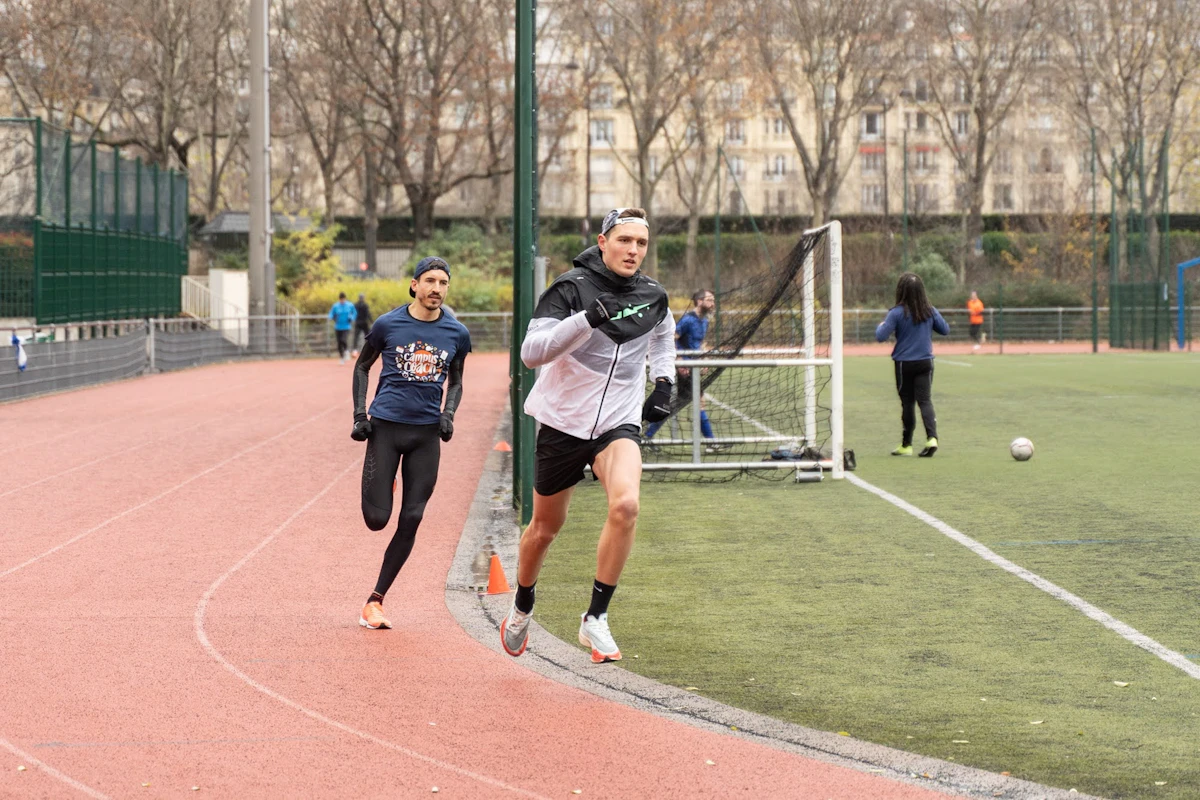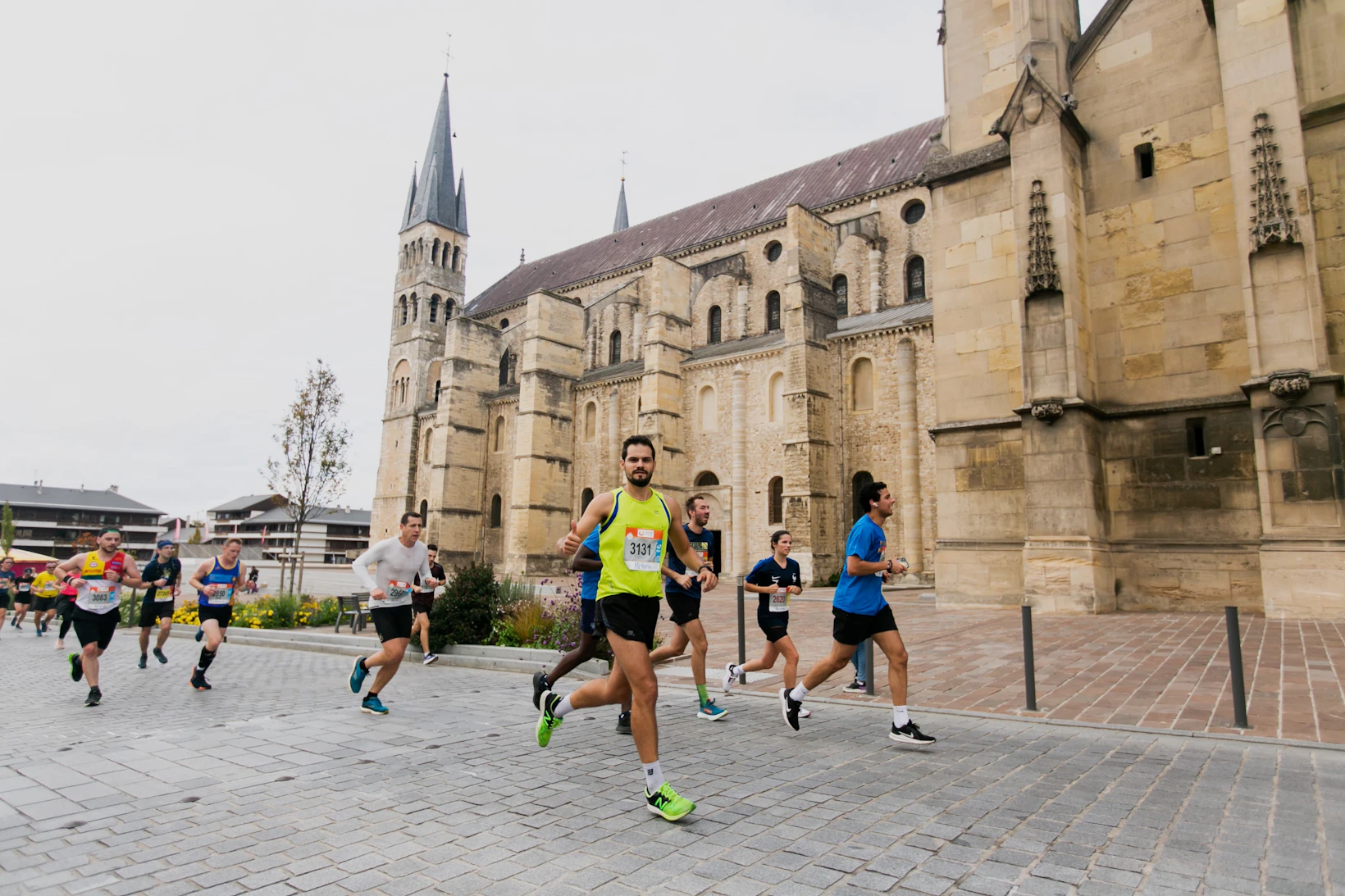What is the purpose of an interval workout to prepare for a race?

9 min read
Summary
What is interval training in running?
To improve MAS but not only
The different levers of an interval workout
What is the benefit of interval running?
Running longer in the target zone
Improve your muscular efficiency and stride
Work on your race pace
Boost your mental strength
What precautions for beginners?
Fartlek, a good introduction
How to properly do an interval session?
The structure of an interval workout
Active or passive recovery?
The paces, you shall respect
How many interval training workouts per week?
What is the best interval for your race?
The 30/30, the MAS variations (
Long intervals (3,1 miles pace to threshold 30)
Threshold (30'T to 60'T)
Interval training at specific pace
Special Campus workouts

Receive advice from our passionate coaches!
It's essential in all training plans for those looking to progress efficiently. Whether you're aiming to progress or simply prepare at your best for your next race, from 5 km to marathon, from short trails to ultra-trails, you'll surely find interval workouts suited to your profile and goals.
These workouts, more demanding and intense than traditional base endurance runs, are not necessarily synonymous with high-speed races around a track; far from it. Intervals can be practiced at different paces, on various terrains.
The benefits of intervals are numerous and proven. These exercises are the ones that will generate the most adaptations, both physiological and mechanical. Take care not to overuse them and to respect the indicated paces.
What is interval training in running?
At its core, the term interval is derived from track training. Sometimes referred to as interval training or more rarely as intermittent training to define the same type of workouts.

To improve MAS but not only
Interval training involves alternating segments of sustained pace with recovery segments over one or several sets. The most famous one is the popular 30/30. It contrasts with continuous training, where you need to run for a set duration or distance without recovery. For example, when you run for 30 minutes continuously at the 60' Threshold, that's continuous training. But if you do 6×5 minutes with 2 minutes of recovery, you're doing interval training.
You've probably heard of interval training to describe the fastest training sessions like MAS (Maximal Aerobic Speed) or sprint workouts. Yet in reality, the principle of intervals can apply to any pace. The beginner runner who alternates between running and walking is doing intervals without realizing it. Same for someone resuming after an injury. Interval running can pursue very different goals, such as developing your aerobic or anaerobic system, aiming for neuromuscular improvement, or specifically working on your race pace.
The different levers of an interval workout
Many parameters can be adjusted to vary the difficulty of an interval workout. Starting with the intensity, distance (or duration) of the effort segments and the ratio between work and recovery time. Indeed, doing 30/30 workouts will be easier than a 30/15 workout at the same target speed.
You can also change the number of effort segments (called sets on Campus) and possibly the number of series. You can also switch up the terrain, whether on track, road, in nature, or uphill. All these parameters combined offer an enormous variety of workouts, almost limitless.
What is the benefit of interval running?
The benefits of intervals are numerous. You'll soon understand why these exercises are indispensable for runners seeking to progress effectively.
Running longer in the target zone
The initial idea is clear. To improve at a certain intensity of effort, you just need to get accustomed to running long at that intensity and in the targeted physiological zone. This work will allow you to stimulate specific physiological adaptations.
This is the first benefit of interval training. This strategy allows you to accumulate more time running at the target intensity than you could with a continuous effort, leading to faster progress. Because you don’t feel the same level of difficulty, it allows you to recover faster, explanations:
Let's take the example of a MAS workout. Here we aim to develop your maximal oxygen consumption (or VO2 Max) with extended time in this very intense effort zone. During a MAS pace workout, your heart operates at a high rate, over 95% of your Maximum Heart Rate. The goal is to accumulate a good duration of effort at this high level.
Let’s assume your MAS is 14 km/h (8.70 mph), which corresponds to a pace of 4 minutes 15 seconds per kilometer (6 minutes 51 seconds per mile). In a continuous run, you must be able to sustain this pace for 5 to 6 minutes maximum, or a distance of 1,200 (0.75 mile) to 1,400 meters (0.87 mile).
Now imagine doing an interval of 10 x 1' / 1' at 100% of your MAS. In terms of perception, this session is less difficult than a 6-minute MAS test (half Cooper). Yet it allows you to run at your MAS pace for 10 minutes, over 2,300 meters (1,43 mile).
That's almost twice as much as in a continuous run, while generating less fatigue and thus boosting your recovery. It's a winning combination for your progress.

Improve your muscular efficiency and stride
Another benefit of intervals is the improvement of your muscular efficiency. Running longer in the target effort zone will not only lead to physiological adaptations (your aerobic and anaerobic systems) but also mechanical ones.
And if the speed is significantly above the MAS, one can even work on neural factors allowing better inter and intramuscular coordination.
Intervals, often associated with form drills (the famous range), help improve your running form and stride. That is to make it more efficient, economical. You'll lose the least energy possible and use the maximum energy moving forward. Uphill interval exercises will promote a natural strength & conditioning work.
Work on your race pace
All training plans follow a certain logic of progression. The sequence of workouts and consistency are what will bring progress.
If you're preparing for a 10K (6.21 miles), no plan will suggest running 7 or 8 km (4.35 or 4.97 miles) in a row at your race pace. It would be far too demanding and counterproductive. However, it is common to suggest a 6, 7, or even 8 × 1,000 meters (0.62 mile) at the target pace with recovery times of 1 minute 30 seconds to 2 minutes between each 1,000 meters (0.62 mile). Such sessions allow you to work on your race pace over a good volume while generating much less fatigue compared to the same effort in a continuous run.
Boost your mental strength
Intervals have another advantage, psychological this time. For your brain, splitting the effort makes it less difficult. However, we won’t lie to you. An interval session, even the easiest on paper, will always be more demanding than an easy run in base endurance. When your Campus Plan shows a difficulty level of 5 out of 5, you know what to expect. These sessions will challenge you both physically and mentally, repeating intense efforts, sometimes close to your maximum. It's intentional and beneficial. You must mentally prepare for what awaits you on race day.
What precautions for beginners?
Here we specifically address the case of short and intense intervals. Fast exercises heavily engage your cardiorespiratory system, but also your muscles, tendons, and joints. They can leave marks or even lead to injury if your body isn't ready to handle these new challenges. So, if you're new to running, start by getting into the habit of running two or three times a week at a slow or moderate pace. Little by little, your body will naturally strengthen, and you will build the base endurance to better absorb your future interval sessions.

Fartlek, a good introduction
Fartlek or "pace play" in Swedish is a good alternative to intervals for beginners and a good supplement for more experienced runners. Ideally practiced in nature on rolling terrain. In fartlek, you forget about the stopwatch and paces. You run by feel according to the terrain, alternating between slow and fast runs as you wish. It's very insightful to discover how your body reacts based on the effort intensity. The other advantage of fartlek, for a beginner or when restarting after a break, is changing the type of terrain. Running on soft surfaces (trails, grass) will stress your body less than on hard ground.
How to properly do an interval session?
An important tip: do not jump "cold" into an interval session without warming up beforehand. Otherwise, you wouldn’t be able to give your best effort during the session, and worse, you risk injury. The faster the target pace, the more you need to focus on your warm-up.
The structure of an interval workout
A session is comprised of three parts. First, a warm-up lasting around twenty minutes at a slow pace to gently raise the cardio and smoothly activate your body. You’ll complete this warm-up with some drills or ranges - high knees, butt kicks, straight-leg running, bounding strides - promoting good running form, and end your warm-up with a few accelerations.
Then, it's time to tackle the core of the session. For example, two sets of 6×300 meters (0.19 mile) with 100 meters (0.06 mile) of recovery. Once both sets are done, your session isn't quite finished.
Your body has just been operating at full throttle. It's important to let your body gradually return to a resting state. This last part is called the cool-down. It consists of a slow jog for about ten minutes. Cooling down benefits your recovery and the sequence of sessions.
Active or passive recovery?
The duration and intensity of the recovery strongly impact the challenge of an interval workout. We refer to passive recovery when you remain stationary or walk slowly between each fast-running interval and active recovery when you continue jogging.
Except for particular cases like sprints, we generally favor active recovery. The idea is to keep running slowly between the fast intervals (between 50 and 55% of your MAS). We might choose passive recovery in an intensive objective to work on a mechanical aspect or a speed weakness. This involves more sets or intervals of work at higher speed; it's a trade-off.
Because when opting for active recovery, the emphasis is placed on density and volume by increasing mileage and physiological workload at the expense of intensity. The benefit is to "save time" just like shortening recoveries, an interesting option for long distances.

The paces, you shall respect
It's a common mistake, not just among beginners, to try to run faster than the paces given by your coach or training plan. Most of the time, this desire to "do well" proves counterproductive. Indeed, running too fast means you are no longer working on the specific quality targeted during your workout, and you are not respecting the progressive logic of your plan. There’s also the risk of recovering poorly after your workout and therefore progressing less. We progress not through an interval workout but through the accumulation of intense workouts week after week. And to achieve this effect, you must manage intensity and not always be at full throttle. In running, no pain no gain is not always the way to go.
If you want to reap the maximum benefit from your interval workout, try to keep your enthusiasm in check at the beginning - intervals are not sprints - and to be as consistent from the first to the last interval. Another winning strategy is to escalate the effort, but never the other way around.
How many interval training workouts per week?
If you run three times a week or less, limit yourself to one interval workout per week. If you run at least four or five times a week, you can integrate a second interval into your plan. Above that, it only concerns a minority of runners aiming for high performance.
Except for some elites, the rule is to never do two interval workouts in a row to allow enough recovery time. Remember, it's the training + recovery combo that drives progress.
Always try to fit in at least one easy run between two workouts. In general, 48 hours is enough to recover. If you're a beginner, we recommend leaving three days between two workouts. Remember that base endurance should make up 70 to 80% of your weekly volume. Most workouts are ultimately done with easy breathing.
What is the best interval for your race?
The 30/30, the MAS variations (short intervals): how to do them?
Short intervals or MAS variations always have their place in a training plan, regardless of the distance you are preparing for. This ranges from the 30/30 (30 seconds of fast running then 30 seconds of slow running) to segments of around 2 minutes. Workouts can be very diverse like a workout of 40×400 with 1 minute of recovery at 60' Threshold pace. The shorter the race format, the more important the short intervals become. However, even if you're preparing for a marathon, it's beneficial to work on your speed qualities, at least at the start of your training plan. Ensure you don’t go too fast because the rapid workouts are the most taxing on your body.
Long intervals (3,1 miles pace to threshold 30)
Starting from 2-minute fractions of effort up to about 4 minutes, this is referred to as long interval training. These workouts are very useful because you will maintain an intense effort for a relatively long period. You will run between 90 and 95% of your MAS and improve your resistance to effort. This type of interval is interesting from a physiological and mechanical point of view, regardless of the format prepared, from 5 km (3,1 miles) to marathon.
Threshold (30'T to 60'T)
At Campus, we use the concepts of 30'T, meaning the pace you can maintain for 30 minutes, and 60'T. For the majority of runners, these two paces encompass the 10 km (6.2 miles) pace. For more advanced runners, the 60' T pace is close to the half-marathon pace.
In this type of workout, the intervals are long and the recoveries are short. These are, for example, 4 x 6 minute workouts with 2' recovery between each interval, or even 3 × 10 minutes with 2'30\" recovery. Training at 30' T and 60' T helps gauge your fitness level. It is very useful for formats starting from 10 km (6.2 miles).

Interval training at specific pace
Any preparation plan includes interval workouts at the target specific pace for race day. It's about gradually familiarizing yourself with this intensity of effort to maintain it over the total distance on race day. In a 10 km (6.2 miles) plan, you will work on your specific pace with intervals between 3 to 8 minutes (around 1km/0.62 mile to 2km/1.24 mile). To prepare for a half-marathon, intervals can be up to 15 minutes (2km/1,24 mile to 4km/2,49 miles). And reach 25 to 30 minutes to prepare for a marathon. Here, the focus is on the endurance index, meaning your ability to run at a fairly sustained pace for a long duration.
Special Campus workouts
At Campus, we like to offer in our training plans mixed interval workouts. This allows you to work on several qualities in a single workout. We can mention strength + pace workouts. The principle is to follow a speed block (for example, 3 sprints of 35 to 45 seconds with long recoveries) and then a race pace block. The goal of these workouts is to create fatigue (mechanical, muscular, nervous, energetic) to start the pace block already fatigued and replicate race conditions.
Workouts with pace variations involve reducing the time of each repetition while increasing the pace, and then doing the reverse. For example, the dreaded Evil Kenivel workout in which you will chain successively 60' T, 30' T and MAS paces.
These home workouts demonstrate that the variety of interval workouts is endless. For your greatest pleasure!












